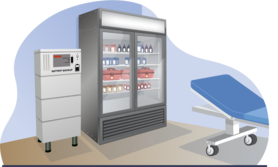
CR4HC Heat Element 3.5: Supply Chain
Element 3.5. Supply Chain
Many items in a healthcare organization’s supply chain – both clinical and non-clinical – require refrigeration. Healthcare organizations can enhance resilience by developing and implementing a plan for managing their refrigerated supply chain and on-site storage during heat-related regional power outages (Rublee et al., 2021).
Download a PDF of this Element
Climate Resilience Actions:
- Integrate storage of medical supplies for heat-related illness into the facility heat preparedness plan: Consider how the healthcare organization's prospective risk assessment of extreme heat events (Element 1) might lead to supply chain disruptions and/or changing needs. Storing sufficient medical supplies for treating patients with heat-related illness can help the facility withstand a temporary pause in deliveries (Hess et al., 2023).
- Boost the resilience of refrigerated storage areas: Consider increasing wall insulation and access to auxiliary power in refrigerated storage areas to extend the shelf life of temperature-sensitive products like pharmaceuticals and food supplies during brownouts and blackouts.
Tools and Resources:
Data and Tools
- Heat Response Plans: Summary of Evidence and Strategies for Collaboration and Implementation: Report summarizing the science behind extreme heat, the health burden of heat exposure, the impacts of climate change, and components and effectiveness of heat response plans with a focus on relevant peer-reviewed literature and existing heat response plans. https://www.cdc.gov/climateandhealth/docs/HeatResponsePlans_508.pdf
- Roundtable Report: Supply Chain Risk Mitigation for Scientific Facilities and Tools: This report summarizes a roundtable convening that discussed the landscape of supply chain risks facing the Office of Scientific and Technical Information (OSTI), particularly with respect to domestic or strategic supply chains. https://science.osti.gov/-/media/hep/pdf/Reports/Supply-chain-risk-mitigation-for-scientific-facilities-and-tools.pdf
People and Operations
- Climate Resilient Health Clinics Toolkit: Extreme Heat Facility Preparedness Guidance: This document, a part of the Americares' Climate Resilient Health Clinics Toolkit and designed for administrators of health centers and clinics, provides guidance on developing policies and procedures for ensuring facilities are resilient and prepared for an extreme heat event. https://www.americares.org/wp-content/uploads/2.-ADMIN.Heat_Facility_Preparedness_Guidance_2023Final.pdf
- Climate Resilient Health Clinics Toolkit: Extreme Heat Immediate Response Checklist: This checklist, a part of the Americares' Climate Resilient Health Clinics Toolkit and designed for administrators of health centers and clinics, provides ideas and steps to help a facility when a heat wave has been forecasted for the local area. https://www.americares.org/wp-content/uploads/ADMIN.PreparednessforExtremeHeat_ImmediateResponse_Checklist_ReviseFINAL.pdf
- Climate Resilient Health Clinics Toolkit: Health Center Power Outage Guidance: This document, a part of the Americares' Climate Resilient Health Clinics Toolkit and designed for administrators of health centers and clinics, provides recommendations for policies or procedures in the event of a power outage that can be included in an Emergency Operations Plan or into a standalone power outage plan to help ensure the safety of staff and patients in the event of a power outage during a heat wave. https://www.americares.org/wp-content/uploads/ADMIN.Heat_HealthCenter_Power_Outages_Final.pdf
- Health Facilities Preparation for Extreme Heat: List that offers guidance to health facilities on effectively safeguarding both staff and patients during heat waves and extreme heat events. https://www.canada.ca/en/health-canada/services/environmental-workplace-health/reports-publications/climate-change-health/health-facilities-preparation-extreme-heat-recommendations-retirement-care-facility-managers-health-canada-2011.html
Physical Infrastructure
- Climate Resilient Health Clinics Toolkit: Long-Term Climate Resilience and Sustainability: The document, a part of the Americares' Climate Resilient Health Clinics Toolkit, is designed for administrators of health centers and clinics to provide ideas and steps that can be taken to enhance resilience to extreme weather and promote healthier and more sustainable communities. https://www.americares.org/wp-content/uploads/ADMIN.Heat_LongTerm_Climate_Change_Resilience_Final.pdf
References
Click on the button below for details of research cited on this page.
Return to the Extreme Heat Landing Page
Elements of Extreme Heat Resilience
1. Prospective Risk Assessment 2. Health Equity and Community Engagement
3. Infrastructure & Operations 3.1. Staff Support 3.2. Clinical Considerations
3.3. Building and Campus: Design & Construction 3.4. Building and Campus: Facility Operations
3.5. Supply Chain 4. Collaboration Between Healthcare Organizations
5. Interdisciplinary Planning, Oversight, and Evaluation 6. Communications & All-Hazards Approach




